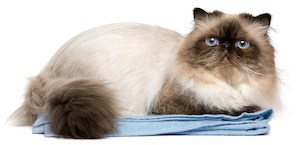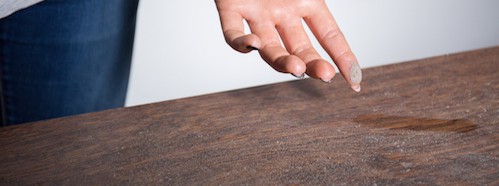Published on February 4th, 2020
Sneezing and wheezing every time you’re around cats or even someone with a cat at home? Itchy skin, red eyes? Runny nose, a rash? You may need to stay away from any feline friends.
But what if you have a cat and you find out you are allergic? Do you just rehome your pet, or can you find a way to co-exist in the same household? Or what if you need to move to a new home where the previous residents have had cats?
If you’re allergic to cat dander, it is crucial to know how to get rid of it – thoroughly. Even small amounts of cats’ dandruff can cause your allergies to flare up. And since cat dander is especially good at tightly latching on to any surface, it is also challenging to remove.

If you are looking for ways to get rid of cat dander, then you’re on the right page. Let's get started!
How to clean your house if you are allergic to cats
- 9 Effective Ways
If you’re sharing a home with a cat that you’re allergic to, there are a few things you can do to control the allergens.
These tips will help you cohabitate with your furry feline companion:
[1.] Restricting your bedroom from your cat
People spend about one-third of their day in the bedroom. If you don’t want to wake up with your eyes swollen and itching and your nose stuffy, you may want to keep your cat away from the room you sleep in.
Many cats just love the comfortable bed, and they would love to cuddle up next to you to enjoy the warmth. But if you’re allergic, you may have to keep your bed and bedroom off bounds.
Here's how to clean your bedroom:

[2.] Removing unnecessary carpeting
Carpets and rugs tend to be the perfect surface for cat dander to latch on to. Vacuuming does help, but it’s even better if you can remove all unnecessary carpeting or any thick area rugs.
The best choice for homeowners with allergies is to have hardwood, tile, laminate, or other such floors. Having no rugs is the ideal choice, but it may not be the style you're looking for.
If you want to decorate your home with area rugs, buy ones that are a low-pile, tightly woven and easily cleaned. Cat dander will be easier to remove from these kinds of materials.
[3.] Brushing your cat regularly
Grooming your cat will help you reduce the amount of dander and hair that is wafted into the air and spread all over your home. The dander that triggers the allergy clings to that cat hair, and by minimizing cat hair in your home, you will be able to minimize cat dander as well.
Brush your cat every day and do it outside if you can. You can even wear a face mask or ask someone else to do the brushing if you feel your allergies acting up because of the close contact with allergens.

[4.] Using an air purifier
Using an air purifier can help you deal with your cat allergy. It can be especially helpful in your bedroom to help you sleep.
The air purifier will filter any dander and cat hair that is floating in the air, reducing allergens in the air you breathe. Make sure your air purifier has a HEPA filter, and it is powerful enough considering the size of the room or area it is used in.
[5.] Vacuuming 10 minutes a day
A handy stick vacuum is what you need to reduce that cat dander in your home on a daily basis. The vacuum should have powerful suction, brush rolls, a motorized brush roll tool for furniture, and a fully sealed HEPA filtration system.
With a stick vacuum, you all you need is a few minutes every day, and you will see a significant change.
- First, you quickly vacuum the carpets and floors in those areas where your cat mostly spends his or her time. If you have a large home, you could consider restricting bedrooms and other such spaces from your cat. This will make cleaning easier as you have to vacuum a smaller area.
- Next, you detach the wand and take a couple of minutes to quickly vacuum all upholstered furniture and other such areas where cat dander most probably has collected. A motorized brush roll tool is the most effective attachment for wiping out pet hair on such surfaces.
- Thirdly, you can pop on the dusting brush and quickly go through other above-floor areas where cat dander might have landed. Unlike old-fashioned dusters, handheld vacuums won’t waft the dust into the air. All the allergy-causing dander will be pulled in and caught by the filter. Even drapes and lampshades can be dusted with a vacuum cleaner.

Just 10-15 minutes each day (or every other day if your allergy is not severe) will do the trick!
Vacuuming is the most effective way of getting rid of small particles, and spending a few minutes vacuuming every day will keep the concentration of cat dander under control. It’s important that the vacuum has a HEPA filter, which will filter out all the allergens and not allow them to be pushed back into the air.
[6.] Keeping cat dander out of bedding
- Make your bed every morning to avoid cat dander from spreading onto your sheets.
- Never sleep with your cat, and if possible, keep your cat away from your bedroom during the day as well.
- Wash the bedding once a week and the duvets and cover once every one or two months.
- Use hot water and a dryer if possible. The dryer is an excellent way of removing dust and dander from not only bedding but clothes as well. Therefore, we recommend one for every pet owner with allergies.
[7.] Washing your cat's toys and bed
Washing your pet's bed and toys is a good way to reduce dander. Especially the bed and other fabric items will be the perfect surface for cat dander to hold onto. And since your cat sleeps in it, there will be a lot of dander that quickly accumulates.
You should keep this in mind already when buying the bed: only pick products that can be washed in the washer or hand washed with soap and warm water. We recommend getting a bed with a removable cover because it can easily be cleaned even every week.
The ideal cat bed has a removable cover that is machine washable and dryable.

[8.] Restricting your cuddling sessions
This may be the most difficult advice to follow, but if you’re severely allergic, you may not have any other choice. Keeping some distance between you and your cat will definitely help you stay away from allergens that trigger your symptoms.
But because you love your cat, you probably will still want to kiss and cuddle him or her. To avoid getting puffy eyes and a runny nose, restrict your cuddling sessions.
Watch your favorite Netflix series with your cat on your lap, but don’t let them into your bed. And after your bonding session, wash your hands and change your clothes to remove allergens.
[9.] Keeping the litter box clean
If you have allergies, keeping the litter box clean is more important than ever.
Some people are not actually allergic to dander but a protein in cat urine. Choose a dust-free cat litter that keeps the allergens from being wafted into the air.
Change the litter often and use gloves and a face mask when doing so.
How often should I clean my home
if a have allergies?
As a cat owner with allergies, you will have to get used to routines. You need to take out that vacuum cleaner every day, and you should wipe all surfaces every week (or even more often if needed).
To keep the allergens (and your symptoms) under control, keeping your home clean is something that needs to be done.
This routine will help you live happily with your cat:
Daily
- brush your cat
- vacuum all critical areas where your cat spends most of his time
- clean up all clutter to minimize hiding places for cat dander
- fold up laundry and put it away
Weekly
- vacuum all other areas of your home
- wipe all surfaces with a moist microfiber cloth
- wash the sheets, ped beds, furniture covers, and other such washable items
- let the dust settle and mop the floor with a microfiber mop pad

Can cat dander
be removed from a house?
But what if you really need to get rid of cat dander in your home? If you have severe allergies and you're moving into a new home that previously housed cats, you may need to do a more thorough cleanup.
These tips will help you remove cat dander from your home.
How long does pet dander stay in a house?
If there has been a cat in a house, it may take up to 20-30 weeks for the concentration of cat dander to come down to a level that is measured it homes with no pets.
Cat dander is specifically good at clinging tight onto all kinds of surfaces, which means that removing is not necessarily an easy task. But even with severe allergies, you usually can move into a house that has been the home to cats. You just need to clean it meticulously before moving in.
How to get rid of cat dander in a new house?
If you’re moving into a new home and you want to do a thorough cleanup to remove cat dander, then this is what you need to do.
The same advice applies if you own a cat, and you want to keep your home as dander-free as possible.

1. Use a powerful vacuum cleaner to vacuum everything. And we mean everything.
- Don’t forget to vacuum vents, windowsills, lampshades, door frames, and any other surfaces or items where cat dander may have latched. It’s also important to thoroughly vacuum all furniture – especially the upholstered ones.
- Pay attention to carpets and area rugs. If you are doing a cleanup before moving into a new home, or if you have allergies and you’re trying to find a way to live with your cat, you should consider removing carpets. But if that is not possible, make sure you vacuum each inch meticulously. You may even want to use a carpet washer for a thorough result.
- Use a vacuum that has powerful suction and the right tools for each surface. Doing this will guarantee the best results. For example, a motorized brush tool will clean upholstered surfaces better than an old-fashioned upholstery tool. The vacuum should have a fully sealed HEPA filtration system to prevent any of the dander leaking out.
2. Open the windows to let the dusty air out and fresh air in
- Vacuuming the house will stir up the air and waft allergens into the indoor air. A lot of dust and small particles will be sucked in by the vacuum, but there will be a lot of allergens that float in the air. Opening the window is a quick way to let that dust-filled air out.
3. Let the dust settle after vacuuming and airing
- You should give it at least 24 hours before you move into the next phase.
4. Wipe ceilings, walls, and floor with a damp microfiber cloth
- Start with the ceiling and move downwards.
- Rinse the cleaning cloth often under running water instead of spreading the dander by using the same water again and again.
5. Clean every nook and crevice
- To remove as much cat dander as possible, you need to vacuum and wipe behind appliances and radiators.
- You may even need to remove baseboards if your allergies are severe.
- It is important to clean every surface as cat dander usually gets wafted absolutely everywhere.
- Don’t forget the vents and air-conditioners.
- You need to be meticulous and clean every nook and crevice.
Remember that if you suffer from allergies, it might be a good idea to let someone else clean your new home before you move in. Professional cleaning companies provide this service, or you could ask for help from a non-allergic friend or family member.
It’s also important to note that your own cleaning equipment should not be used for the task. The dander will contaminate your vacuum, mop, and other cleaning equipment, causing you symptoms the next time you clean.
Can someone with cat allergies
live with a cat?
Yes, if the allergy is not severe and you really put some time and effort into it, you may be able to live with a cat even if you suffer from a cat allergy.
Take your medications as prescribed by your doctor and keep your home clean. It may be possible!
The most important thing is to clean routinely and have the right equipment to get the best results. You have to be thorough and meticulous, but for that beloved furry feline, there nothing you wouldn’t do, right?
Tips for severe allergies!
- Remove or replace carpets whenever possible
- Repaint the interior of your home every few years
- Replace any upholstered furniture with wood, vinyl or leather - these materials don’t trap dander and are easier to clean

